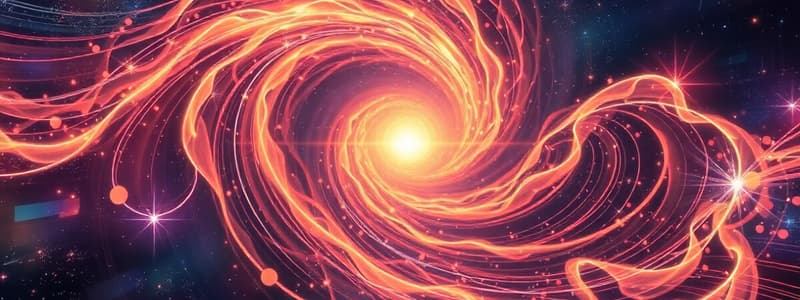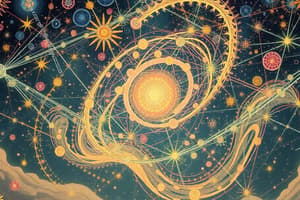Podcast
Questions and Answers
According to the postulates of special relativity, which of the following is true for all observers in uniform motion?
According to the postulates of special relativity, which of the following is true for all observers in uniform motion?
- Time passes at the same rate, regardless of relative motion.
- The speed of light varies depending on the motion of the light source.
- Physical laws remain the same. (correct)
- The measured length of an object remains constant.
What is the primary concept behind general relativity's explanation of gravity?
What is the primary concept behind general relativity's explanation of gravity?
- Gravity is a force exerted directly between two objects.
- Gravity is the result of an object's mass affecting another object.
- Gravity is a result of spacetime being warped by mass and energy. (correct)
- Gravity is a quantum phenomenon mediated by gravitons.
How does the concept of spacetime differ from the classical physics view of space and time?
How does the concept of spacetime differ from the classical physics view of space and time?
- Spacetime treats space as three-dimensional, while classical physics treats it as four-dimensional.
- Spacetime only applies to objects moving at relativistic speeds, while classical physics applies to everyday objects.
- Spacetime considers time to be absolute, while classical physics treats time as relative.
- Spacetime combines space and time into a single, interwoven continuum, while classical physics treats them as independent. (correct)
An astronaut is traveling at 80% of the speed of light relative to Earth. How would observers on Earth perceive the length of the astronaut's spaceship, compared to its length when measured at rest?
An astronaut is traveling at 80% of the speed of light relative to Earth. How would observers on Earth perceive the length of the astronaut's spaceship, compared to its length when measured at rest?
Imagine you are on a spaceship traveling at a very high speed relative to Earth. How would the passage of time on the spaceship compare to the passage of time on Earth?
Imagine you are on a spaceship traveling at a very high speed relative to Earth. How would the passage of time on the spaceship compare to the passage of time on Earth?
As an object's velocity approaches the speed of light, what happens to its relativistic mass?
As an object's velocity approaches the speed of light, what happens to its relativistic mass?
Given the mass-energy equivalence equation $E=mc^2$, what does this imply about mass and energy?
Given the mass-energy equivalence equation $E=mc^2$, what does this imply about mass and energy?
How does gravitational time dilation manifest itself?
How does gravitational time dilation manifest itself?
What causes gravitational lensing?
What causes gravitational lensing?
What is the defining characteristic of a black hole?
What is the defining characteristic of a black hole?
Which of the following generates gravitational waves, according to general relativity?
Which of the following generates gravitational waves, according to general relativity?
Which of the following is an experimental verification of special relativity?
Which of the following is an experimental verification of special relativity?
Which of the following observations supports general relativity?
Which of the following observations supports general relativity?
If you observe two identical clocks, one at sea level and one on a high mountain, which of the following would be true according to general relativity?
If you observe two identical clocks, one at sea level and one on a high mountain, which of the following would be true according to general relativity?
How does relative velocity affect the measurement of an object's length?
How does relative velocity affect the measurement of an object's length?
Imagine a particle with mass. As the particle's kinetic energy increases, which of the following occurs?
Imagine a particle with mass. As the particle's kinetic energy increases, which of the following occurs?
What does the direct detection of gravitational waves confirm?
What does the direct detection of gravitational waves confirm?
Consider two objects with different masses placed in a gravitational field. How would gravitational time dilation affect them?
Consider two objects with different masses placed in a gravitational field. How would gravitational time dilation affect them?
How does strong gravity affect the path of light?
How does strong gravity affect the path of light?
Within the framework of relativity, what is the relationship between energy and mass?
Within the framework of relativity, what is the relationship between energy and mass?
Flashcards
Relativity Definition
Relativity Definition
Gravity described as a geometric property of spacetime.
Special Relativity
Special Relativity
Deals with the relationship between space and time, based on two postulates: constant physical laws and constant speed of light.
General Relativity
General Relativity
Theory of gravitation where mass and energy warp spacetime itself, causing gravitational effects.
Spacetime
Spacetime
Signup and view all the flashcards
Length Contraction
Length Contraction
Signup and view all the flashcards
Time Dilation
Time Dilation
Signup and view all the flashcards
Relativistic Mass
Relativistic Mass
Signup and view all the flashcards
Mass-Energy Equivalence
Mass-Energy Equivalence
Signup and view all the flashcards
Gravitational Time Dilation
Gravitational Time Dilation
Signup and view all the flashcards
Gravitational Lensing
Gravitational Lensing
Signup and view all the flashcards
Black Hole
Black Hole
Signup and view all the flashcards
Gravitational Waves
Gravitational Waves
Signup and view all the flashcards
Study Notes
- Relativity describes gravity as a geometric property of spacetime
Special Relativity
- Describes the relationship between space and time
- Proposed by Albert Einstein in 1905
- Postulates: Physical laws are the same for all observers in uniform motion; the speed of light in a vacuum is the same for all observers, regardless of the motion of the light source
- Introduced spacetime, length contraction, time dilation, relativistic mass, mass-energy equivalence (E=mc^2), and the universal speed limit (speed of light)
General Relativity
- Theory of gravitation developed by Albert Einstein between 1907 and 1915
- Gravitational effect between masses results from their warping of spacetime
- Predicts gravitational time dilation, gravitational lensing, black holes, and gravitational waves
- Experimentally verified to high precision and is the modern theory of gravitation
Spacetime
- Mathematical model combining space and time into a single continuum
- Classical physics views space as three-dimensional and time as independent
- Relativity interweaves space and time into a four-dimensional continuum
- Events occur at specific points in spacetime, defined by their spatial and temporal coordinates
Length Contraction
- A moving object's length is measured to be shorter than its proper length
- Proper length is the object's length in its rest frame
- The faster the relative velocity, the greater the length contraction
Time Dilation
- Time passes slower for a moving observer relative to a stationary observer
- The faster the relative velocity, the greater the time dilation
Relativistic Mass
- Mass of an object as measured by an observer in relative motion with respect to the object
- Relativistic mass increases as its velocity increases
- As an object approaches the speed of light, its relativistic mass approaches infinity
- The concept is sometimes avoided in favor of discussing relativistic momentum and energy
Mass-Energy Equivalence
- Mass and energy are interchangeable
- Expressed by the equation E=mc^2 (E is energy, m is mass, c is the speed of light)
- A small amount of mass can be converted into a large amount of energy, and vice versa
Gravitational Time Dilation
- Time passes slower in regions of stronger gravitational potential
- Time passes slower near massive objects
Gravitational Lensing
- The bending of light around massive objects
- Caused by the curvature of spacetime near massive objects
Black Holes
- Region of spacetime where gravity is so strong that nothing, not even light, can escape
- Formed from the collapse of massive stars
- Characterized by their mass, charge, and angular momentum
Gravitational Waves
- Ripples in spacetime that propagate at the speed of light
- Produced by accelerating massive objects
- Predicted by Einstein's theory of general relativity
- Directly detected for the first time in 2015
Experimental Verification
- Special relativity has been verified by time dilation, length contraction, and mass-energy equivalence measurements
- General relativity has been verified by measurements of gravitational time dilation, gravitational lensing, and the precession of Mercury's orbit
- The discovery of gravitational waves is a major triumph for general relativity
Studying That Suits You
Use AI to generate personalized quizzes and flashcards to suit your learning preferences.




